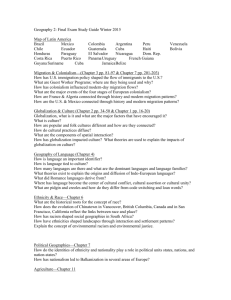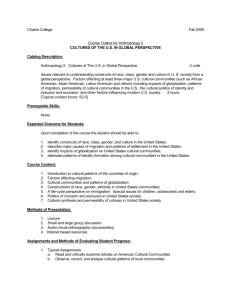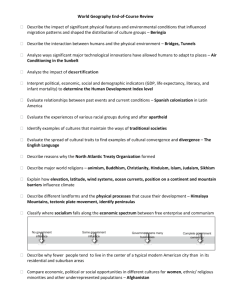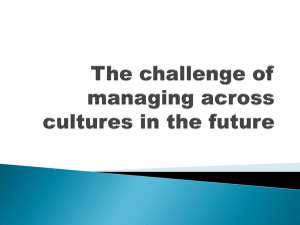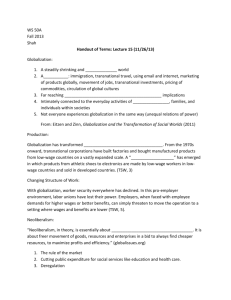Assignment Sheet
advertisement
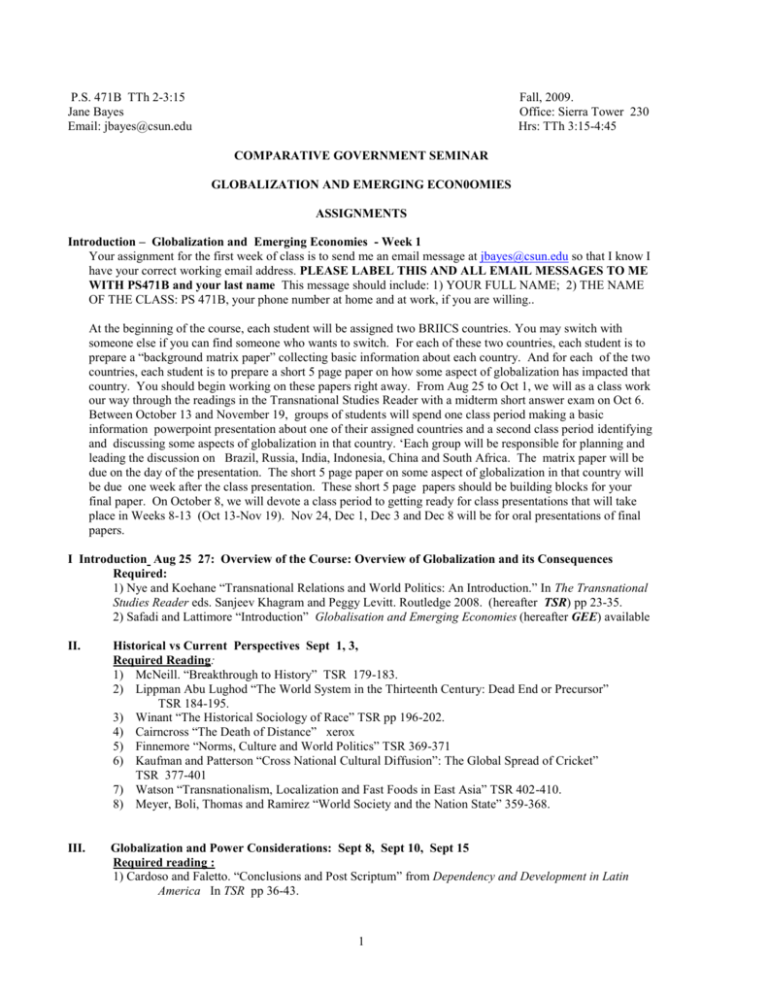
P.S. 471B TTh 2-3:15 Jane Bayes Email: jbayes@csun.edu Fall, 2009. Office: Sierra Tower 230 Hrs: TTh 3:15-4:45 COMPARATIVE GOVERNMENT SEMINAR GLOBALIZATION AND EMERGING ECON0OMIES ASSIGNMENTS Introduction – Globalization and Emerging Economies - Week 1 Your assignment for the first week of class is to send me an email message at jbayes@csun.edu so that I know I have your correct working email address. PLEASE LABEL THIS AND ALL EMAIL MESSAGES TO ME WITH PS471B and your last name This message should include: 1) YOUR FULL NAME; 2) THE NAME OF THE CLASS: PS 471B, your phone number at home and at work, if you are willing.. At the beginning of the course, each student will be assigned two BRIICS countries. You may switch with someone else if you can find someone who wants to switch. For each of these two countries, each student is to prepare a “background matrix paper” collecting basic information about each country. And for each of the two countries, each student is to prepare a short 5 page paper on how some aspect of globalization has impacted that country. You should begin working on these papers right away. From Aug 25 to Oct 1, we will as a class work our way through the readings in the Transnational Studies Reader with a midterm short answer exam on Oct 6. Between October 13 and November 19, groups of students will spend one class period making a basic information powerpoint presentation about one of their assigned countries and a second class period identifying and discussing some aspects of globalization in that country. ‘Each group will be responsible for planning and leading the discussion on Brazil, Russia, India, Indonesia, China and South Africa. The matrix paper will be due on the day of the presentation. The short 5 page paper on some aspect of globalization in that country will be due one week after the class presentation. These short 5 page papers should be building blocks for your final paper. On October 8, we will devote a class period to getting ready for class presentations that will take place in Weeks 8-13 (Oct 13-Nov 19). Nov 24, Dec 1, Dec 3 and Dec 8 will be for oral presentations of final papers. I Introduction Aug 25 27: Overview of the Course: Overview of Globalization and its Consequences Required: 1) Nye and Koehane “Transnational Relations and World Politics: An Introduction.” In The Transnational Studies Reader eds. Sanjeev Khagram and Peggy Levitt. Routledge 2008. (hereafter TSR) pp 23-35. 2) Safadi and Lattimore “Introduction” Globalisation and Emerging Economies (hereafter GEE) available II. Historical vs Current Perspectives Sept 1, 3, Required Reading: 1) McNeill. “Breakthrough to History” TSR 179-183. 2) Lippman Abu Lughod “The World System in the Thirteenth Century: Dead End or Precursor” TSR 184-195. 3) Winant “The Historical Sociology of Race” TSR pp 196-202. 4) Cairncross “The Death of Distance” xerox 5) Finnemore “Norms, Culture and World Politics” TSR 369-371 6) Kaufman and Patterson “Cross National Cultural Diffusion”: The Global Spread of Cricket” TSR 377-401 7) Watson “Transnationalism, Localization and Fast Foods in East Asia” TSR 402-410. 8) Meyer, Boli, Thomas and Ramirez “World Society and the Nation State” 359-368. III. Globalization and Power Considerations: Sept 8, Sept 10, Sept 15 Required reading : 1) Cardoso and Faletto. “Conclusions and Post Scriptum” from Dependency and Development in Latin America In TSR pp 36-43. 1 2) James F. Holifield. “The Emerging Migration State” International Migration Review (IMR) Vol 38#3 Fall 2004 885-912. on line in library 3) Slaughter. “The Real New World Order” TSR 64-71. 4) Sassen “Introduction” and “The State and the Global City’ from Globalization and its Discontents. In TSR pp .72- 81. 5) Beck “The Cosmopolitan Perspective: Sociology of the Second Age of Modernity” TSR. pp. 222-230 6) Modelski. “Introduction” from Transnational Corporations and World Order TSR 411-414. 7) Evans “Imperialism, Dependency and Dependent Development” TSR 415-428. IV. Global Trade/Production Structure and the BRIICS. Sept 17 Sept 22. Required Reading 1) Reyes, Garcia and Lattimore. “The International Economic Order and Trade Architecture” in GEE pp 13-38. 2) Gereffi “The Organization of Buyer driven Global Commodity Chains: How US Retailers Shape Overseas Production Networks.” TSR 429-445. 3) McCann. “Globalization, Multinationals and BRIICS” GEE pp 71-116. 4) Film : “ Global Assembly Line” V. Transnational Problems : Diasporas, Migration, Religion, Security, Crime, Violence Sept 24, 29 Required Reading I will make assisgnments: 1) Tololyan “The Nation State and Its Others: In Lieu of a Preface” TSR 231-234 2)Hannerz. “Nigerian Kung Fu, Manhattan fatwa” and “The Local and the Global” Continuity and Change” TSR. 235-250 3) Grewal and Kaplan “Introduction: Transnational Feminist Practices and Questions of Postmodernity” in TSR 251-260. 4) Basch, Schiller and Blanc. “Transnational Projects: A New Perspective ‘ and “Theoretical Premises” TSR 261 -272. 5) Kriesberg “Social Movements and Global Transformation” TSR 490 6) Keck and Sikkink “Conclusions: Advocacy Networks and International Society” TSR 501-514 7) Naples. “”The Challenges and Possibilities of Transnational Feminist Praxis” TSR 514-530 VI. Transnational Problems continued: Security, Crime, and Violence 1) Nadelmann ‘Global Prohibition Regimes: The Evolution of Norms in International Society” TSR 531 2) Shelley “Transnational Organized Crime: An Imminent Threat to the Nation State?” TSR 540 3) Kaldor “ Introduction” New and Old Wars: Organized Violence in a Global Era. TSR 535 4) Kyle and Dale “Smuggling the State Back in: Agents of Human Smuggling Reconsidered” TSR 563. VII. Review for Midterm Oct.1 Midterm Oct 6. Oct 8 - Prepare country papers each student must do two VIII. Brazil Oct 13,15 For each country a group will present range of issues about Brazil including trade - imports and exports- , finance and financial institutions, foreign direct investment, migration – internal and external , labor, business and the middle class, government, civil society, crime and corruption, income differentials and welfare, religion and culture, human capital, education, demography, energy and resource dependence. Why is the country a BRIICS? Secondly, Brazil group will identify two or three ways that globalization has impacted Brazil - migration, finance, trade, environment, political ideas/culture Required Reading The Economist Special Report on Brazil - 2 Lattimore and Kowalski - Brazil in Globalization and Emerging Economies” GEE Chapter 6. IX. Russia Oct 20,22 The Economist Special Report on Russia Tarr. “Russia” in Globalization and Emerging Economies X. India Oct 27,29 The Economist Special Report on India Kolowski, Dihel, Garcia. “India” in Globalization and Emerging Economies XI Indonesia Nov 3 5 The Economist Special Report on Indonesia Molnar and Lesher. “Indonesia: in Globalization and Emerging Economies XI. China Nov 10, 12 The Economist Special Report on China Green, Tsai, and Lattimore “China” in Globalization and Emerging Economies XII. South Africa Nov 17 19 The Economist Special Report on South Africa Kowalski, Lattimore and Bettina “South Africa” in Globalization and Emerging Economies IX. Oct 21,23 Week to choose final paper topic and start on bibliographic essay. You should choose two options for your First preliminary written statement of paper topic due on October 28 in class – this can be a couple of options if you are not sure . You should research what sources are available for each if you do more than one. October 30. Final written one page statement of final paper topic. XIII. Student Reports: Nov 24 XIV. Student Reports Dec 1 XV. Student Reports Final paper is due Dec 3 XVI. Student Reports : Dec 8 Student Presentations ALL PAPERS ARE DUE ON Dec 3. ANY STUDENT WHO DOES NOT TURN IN HER/HIS PAPER AT THIS TIME WITH PROPER FOOTNOTING WILL BE DOCKED A GRADE AND MUST WRITE AN ESSAY ON THE FINAL EXAM INSTEAD OF WRITING THE PAPER. I WILL NOT ACCEPT LATE PAPERS. ALL PAPERS MUST BE SUBMITTED IN ELECTRONIC AND HARD COPY FORM. Compare two emerging countries across a range of issues including trade including imports and exports, finance and financial institutions, foreign direct investment, migration – internal and external , labor, business and the middle class, government, civil society, crime and corruption, income differentials and welfare, religion and culture, human capital, education, demography, energy and resource dependence, LIST OF ARTICLES THAT ARE ON LINE AND CAN BE ACCESSED BY CLICKING ON LINKS BELOW: These are from the Migration Policy Institute on line journal Source at: http://www.migrationinformation.org/ which can also be googled by name to find them as well. Another good on line source is the International Migration Review Journal available on line from the CSUN library. 3 Africa – Western Mediterranean Changing Configurations of Migration in Africa Aderanti Adepoju of the Human Resources Development Centre in Lagos provides an overview of Africa's dynamic migration flows, examining trends ranging from feminization to diversification. Shaping Brazil: The Role of International Migration South America's largest country has experienced waves of immigration and, more recently, emigration. But Brazil has not proactively addressed new migration patterns, including increases in illegal immigrants. Ernesto Friedrich Amaral of the University of Texas at Austin and Wilson Fusco of Universidade Estadual de Campinas report. Cross-Border Human Flows in Northeast Asia Tsuneo Akaha of the Monterey Institute of International Studies looks at emerging migration patterns in North Korea, China, Russia, and Japan.2004 China: From Exceptional Case to Global Participant Ronald Skeldon of the University of Sussex maps out the migration patterns and policies of China, the source of tens of millions of migrants around the globe. Indonesia's Labor Looks Abroad A classic labor-surplus nation, Indonesia sends thousands of low-skilled workers every year to countries in the Middle East and elsewhere in Asia, particularly neighboring Malaysia. Graeme Hugo of the University of Adelaide provides an updated look at this and other migration trends in the world's fourth most populous country. Causes of South-South Migration and Its Socioeconomic Effects Migrants' networks and relatively small travel distances help explain migration from one developing country to another. Dilip Ratha and William Shaw of the World Bank look at these and other reasons for and effects of SouthSouth migration. Migration Dilemmas Haunt Post-Soviet Russia As Russia enters the 21st century, it is confronting a set of migration issues unimaginable just a decade ago. Timothy Heleniak of the World Bank and Georgetown University's Center for Eurasian, Russian, and East European Studies maps out the complex past and difficult present of the world's largest country. Georgia Looks West, But Faces Migration Challenges at Home Although Georgia eventually wants to join the European Union, it must first confront its large population of internally displaced persons and high rates of emigration. MPI's Joanne van Selm takes a detailed look at a country in transition. Europe Attracts More Migrants from China Frank Laczko of the IOM examines how increasing numbers of Chinese immigrants are entering Europe. Caught Between East and West, Ukraine Struggles with Its Migration Policy Since its independence in 1991, Ukraine has expanded immigration and emigration rights – but it has also become a neighbor of the expanded European Union, a crossroads for illegal migration, and fertile ground for human traffickers. Olena Malynovksa of the National Institute for International Security Problems in Kyiv reports. 90.17% Short Paper topics Compare how some pattern of globalization has impacted a BRIICS country. You can compare one pattern of globalization in two different countries or two different patterns in two different countries being sure to explain why you picked what you picked. Some example paper topics: 1) Comparing the way that Russia and China have transitioned into globalization of trade and finance after being isolated from the global economy. 2) Comparing China and India with regard to their resources and global development strategies. 3) Comparing Indonesia and South Africa with regard to migration and labor 4) Comparing religious backlash in India and Indonesia. 5) Comparing migration and/or diasporian relations in any two BRIICS countries 6) Comparing global crime and corruption in any two BRIICS countries 7) Showing how one kind of globalization pattern is prevalent in one country while another is prevalent in another. 8) Comparing how globalization has impacted women in two of the BRIICS countries 4 9) Comparing how globalization has created or demolished the middle class in two BRIICS countries. 10) Comparing what globalization has done with regard to changing patterns of labor or patterns of consumption in two BRIICS countries. 5
